1.面向对象的初步认知
1.1什么是面向对象
java是一门纯面向对象的语言,在面向对象的世界里,一切皆为对象.面向对象是解决问题的一种思想,主要依靠对象之间的交互来完成一件事.
1.2面向对象与面向过程的区别
举个例子:
1.传统洗衣服过程

传统的方式: 注重的是洗衣服的过程,少了一个环节都不行.
而且不同衣服洗的方式,时间长度,拧干方式都不同,处理起来就比较麻烦。如果将来要洗鞋子,那就是另 一种放方式。

总共有四个对象: 人 , 衣服 , 洗衣粉 , 洗衣机
整个洗衣服过程: 人将衣服发放进洗衣机,倒入洗衣粉,启动洗衣机,洗衣机就会完成洗衣服过程并且甩干
整个过程主要是: 人 , 衣服 , 洗衣粉 , 洗衣机四个对象之间交互完成的,人不需要关心洗衣机具体是如何洗衣服的,是如何甩干的
2.类的定义和使用
2.1简单认识类
2.2类的定义格式
//创建类
class Test {
field;//成员变量(属性)
method;//成员属性或方法
}
class为定义类的关键字,ClassName为类的名字,{}中为类的主体。
class WashMachine{
public String brand;//品牌
public String type;//型号
public double weight;//长度
public double width;//宽
public double height;//高
public String color;//颜色
public void washClothes(){
//洗衣服
System.out.println("洗衣功能");
}
public void dryClothes(){
//脱水
System.out.println("脱水功能");
}
public void setTime(){
//定时
System.out.println("定时功能");
}
3.类的实例化
3.1什么是实例化?
定义了一个类,就相当于在计算机中定义了一种新的类型,与int,double类似,只不过int和double是java语言自带的内置类型,而类是用户自己定义的一个新的类型,比如上述的:WashMachine.有了自定义类型之后,就可以使用这些类来定义对象了.
class WashMachine{
public String brand;//品牌
public String type;//型号
public double weight;//长度
public double width;//宽
public double height;//高
public String color;//颜色
public void washClothes(){
//洗衣服
System.out.println("洗衣功能");
}
public void dryClothes(){
//脱水
System.out.println("脱水功能");
}
public void setTime(){
//定时
System.out.println("定时功能");
}
public static void main(String[] args) {
WashMachine washMachine1 = new WashMachine();//通过new实例化对象
washMachine1.brand = "小天鹅";
washMachine1.color = "黑色";
washMachine1.dryClothes();
System.out.println(washMachine1.brand);
System.out.println(washMachine1.color);
System.out.println("=============================");
WashMachine washMachine2 = new WashMachine();
washMachine2.brand = "海尔";
washMachine2.color = "白色";
washMachine2.dryClothes();
System.out.println(washMachine2.brand);
System.out.println(washMachine2.color);
}
}
//输出结果:
脱水功能
小天鹅
黑色
=============================
脱水功能
海尔
白色
3.2 类和对象的说明
4.this引用
4.1为什么要有this引用
class Date {
public int year;
public int month;
public int day;
public void setDate(int y, int m,int d) {
year = y;
month = m;
day = d;
}
public void printDate(){
System.out.println(year + "/" + month + "/" + day);
}
public static void main(String[] args) {
//构造三个日期类型的对象d1 d2 d3
Date d1 = new Date();
Date d2 = new Date();
Date d3 = new Date();
d1.setDate(2024,7,19);
d2.setDate(2024,7,20);
d3.setDate(2024,7,21);
d1.printDate();
d2.printDate();
d3.printDate();
}
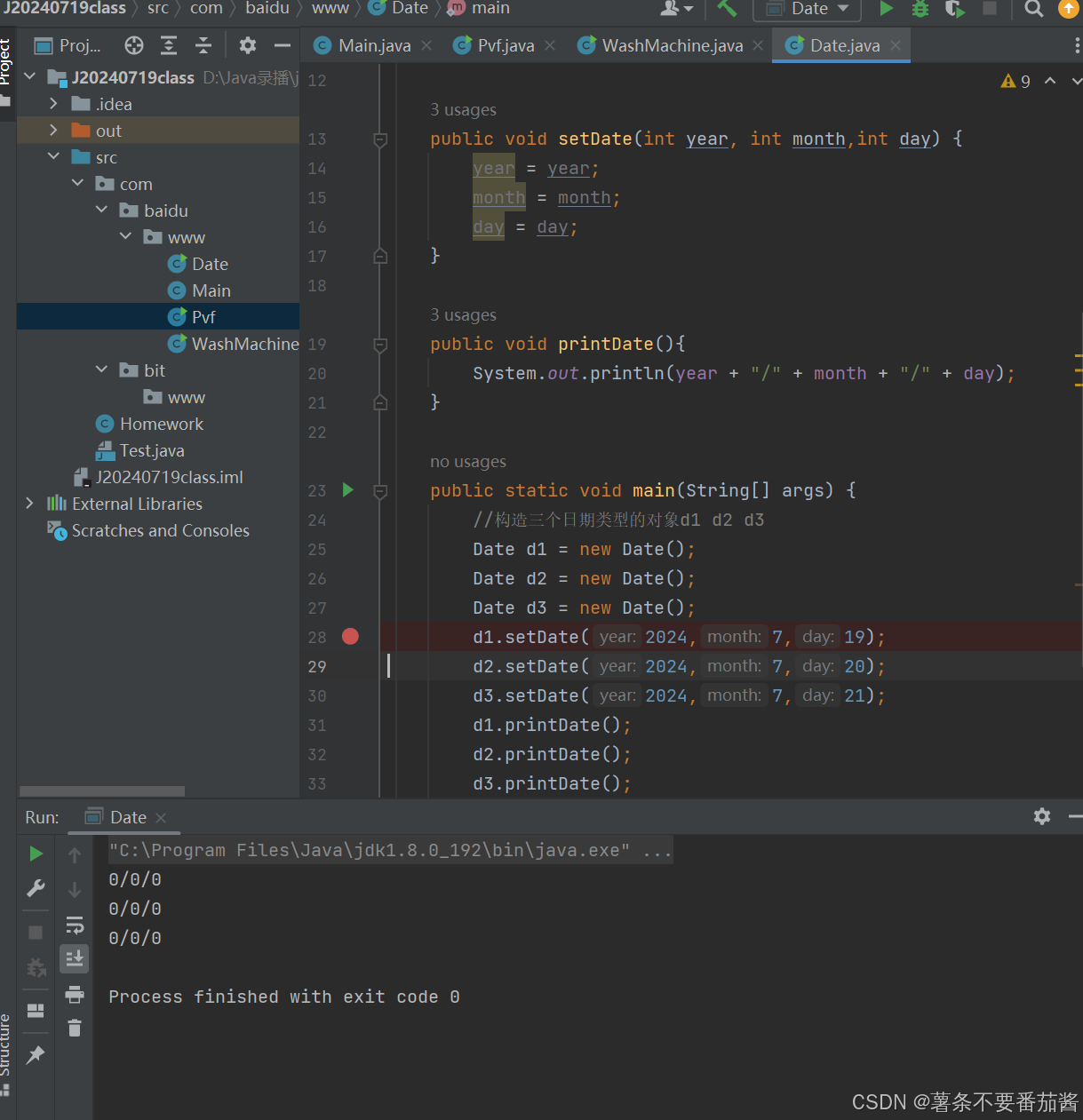
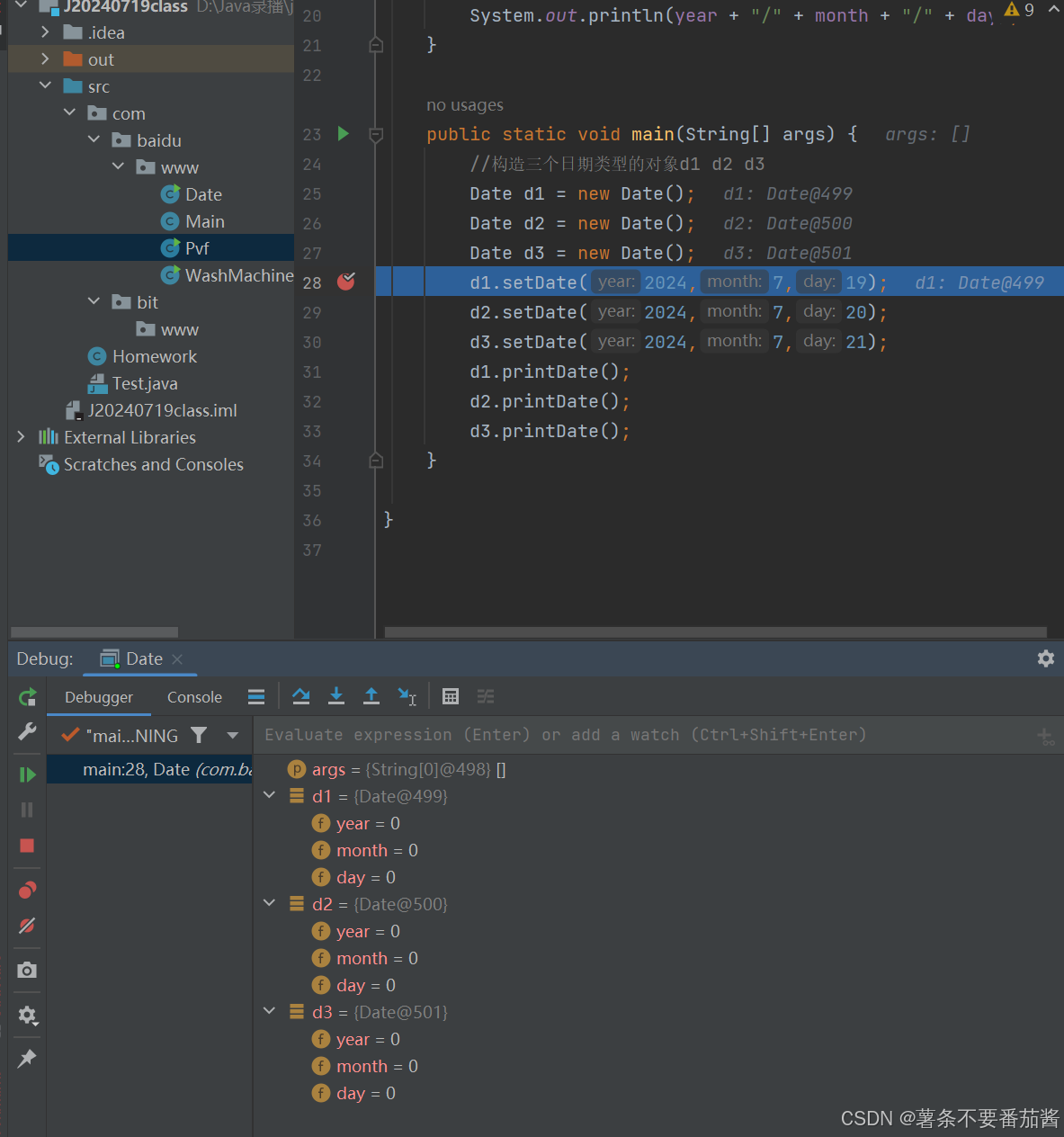
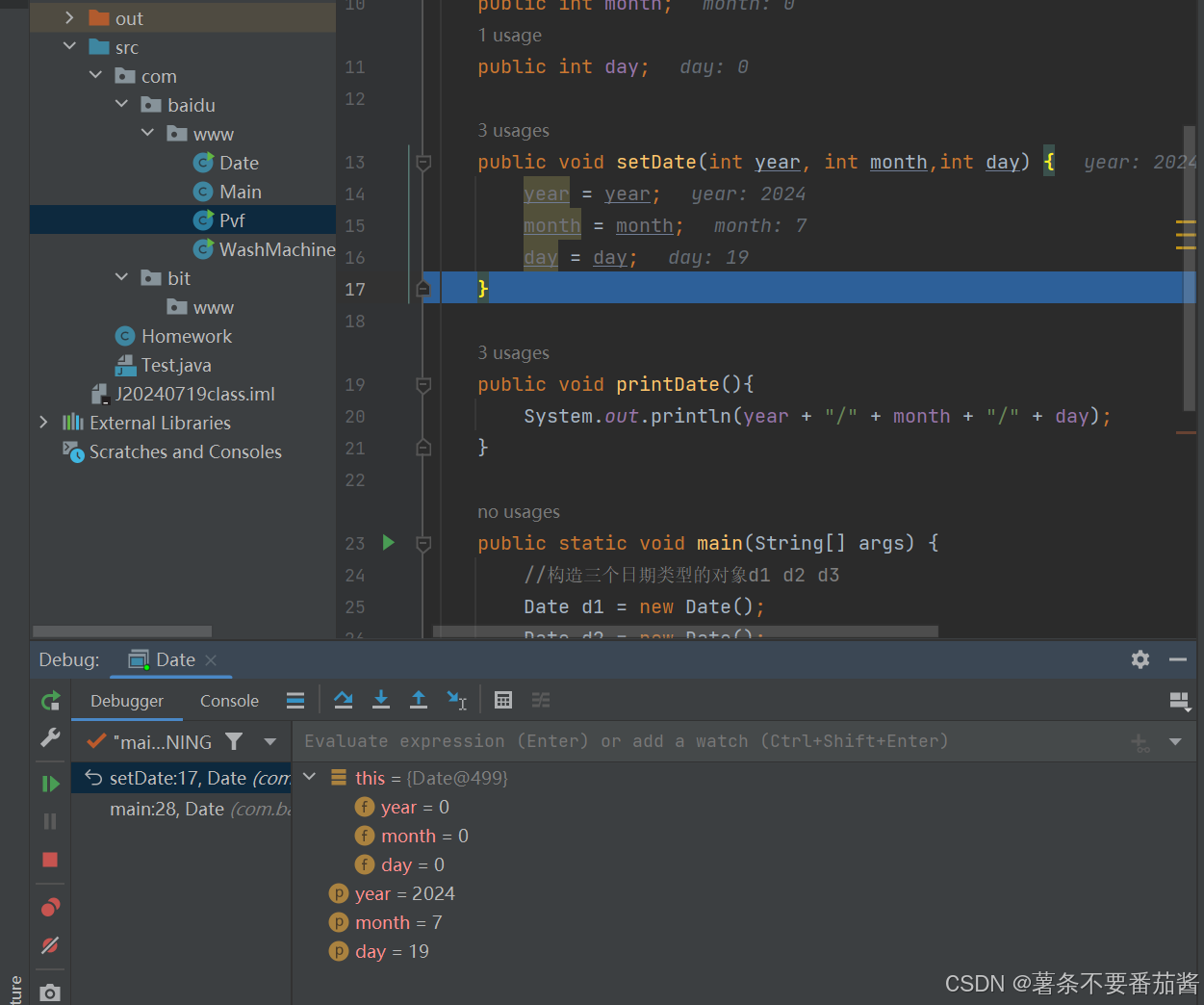
4.2什么是this引用
this引用指向当前对象(成员方法运行时调用该成员方法的对象),在成员方法中所有成员变量的操作,都是通过该引用去访问。只不过所有的操作对用户是透明的,即用户不需要来传递,编译器自动完成。
public class Date {
public int year;
public int month;
public int day;
public void setDate(int year, int month,int day) {
this.year = year;
this.month = month;
this.day = day;
}

可以发现,利用this引用4.1的问题成功得到解决
4.3this引用的特性
1.this的类型:对应类类型引用,即哪个对象调用就是哪个对象的引用类型
2.this只能在"成员方法"中使用
3.在"成员方法"中,this只能引用当前对象,不能再引用其他对象

5.对象的构造及初始化
5.1如何初始化对象
public class Main {
public static void main(String[] args) {
double d;
System.out.println(d);
}
}//编译错误:java: 可能尚未初始化变量d
public static void main(String[] args) {
//继上述Date类
Date d1 = new Date();
d1.printDate();
d1.setDate(2024,7,19);
d1.printDate();
}//代码可以正常运行
5.2构造方法
5.2.1概念
public class Date {
public int year;
public int month;
public int day;
//构造方法
//名字与类名相同,没有返回值类型,设置为void也不行
//一般情况下使用public修饰
//在创建对象时由编译器自动调用,并且在对象的生命周期内只调用一次
public Date(int year, int month,int day) {
this.year = year;
this.month = month;
this.day = day;
System.out.println("Date(int,int,int)方法被调用了");
}
public void printDate(){
System.out.println(year + "/" + month + "/" + day);
}
public static void main(String[] args) {
//构造三个日期类型的对象d1 d2 d3
Date d1 = new Date(2020,7,19);
d1.printDate();
}
}
5.2.2特性
public class Date {
public int year;
public int month;
public int day;
//构造方法
//名字与类名相同,没有返回值类型,设置为void也不行
//一般情况下使用public修饰
//在创建对象时由编译器自动调用,并且在对象的生命周期内只调用一次
public Date(){
this.year = 2003;
this.month = 11;
this.day = 25;
}
public Date(int year, int month,int day) {
this.year = year;
this.month = month;
this.day = day;
System.out.println("Date(int,int,int)方法被调用了");
}
public void printDate(){
System.out.println(year + "/" + month + "/" + day);
}
public static void main(String[] args) {
//构造三个日期类型的对象d1 d2 d3
Date d1 = new Date();//此时调用的是无参Date()
d1.printDate();
}
}
public class Date {
public int year;
public int month;
public int day;
//构造方法
//名字与类名相同,没有返回值类型,设置为void也不行
//一般情况下使用public修饰
//在创建对象时由编译器自动调用,并且在对象的生命周期内只调用一次
public void printDate(){
System.out.println(year + "/" + month + "/" + day);
}
public static void main(String[] args) {
//构造三个日期类型的对象d1 d2 d3
Date d1 = new Date();//此时调用的是无参Date()
d1.printDate();
}
}
public class Date {
public int year;
public int month;
public int day;
// 无参构造方法--内部给各个成员赋初始值,该部分功能与三个参数的构造方法重复
// 此处可以在无参构造方法中通过this调用带有三个参数的构造方法
// 但是this(1900,1,1);必须是构造方法中第一条语句
public Date(){
this(1970,10,25);
}
//带有三个参数的构造方法
public Date(int year,int month,int day){
this.year = year;
this.month = month;
this.day = day;
}
public void printDate(){
System.out.println(year + "/" + month + "/" + day);
}
}
public Date(){
this(1970,10,25);
}
//带有三个参数的构造方法
public Date(int year,int month,int day){
this();
}//编译错误:java: 递归构造器调用
5.3默认初始化
在上文中提出的第二个问题:为什么局部变量在使用时必须要初始化,而成员变量可以不用初始化?
public class Date {
public int year;
public int month;
public int day;
public Date(int year, int month, int day) {
// 成员变量在定义时,并没有给初始值, 为什么就可以使用呢?
System.out.println(this.year);
System.out.println(this.month);
System.out.println(this.day);
}
public static void main(String[] args) {
// 此处a没有初始化,编译时报错:
// Error:(24, 28) java: 可能尚未初始化变量a
// int a;
// System.out.println(a);
Date d = new Date(2021,6,9);
}
}
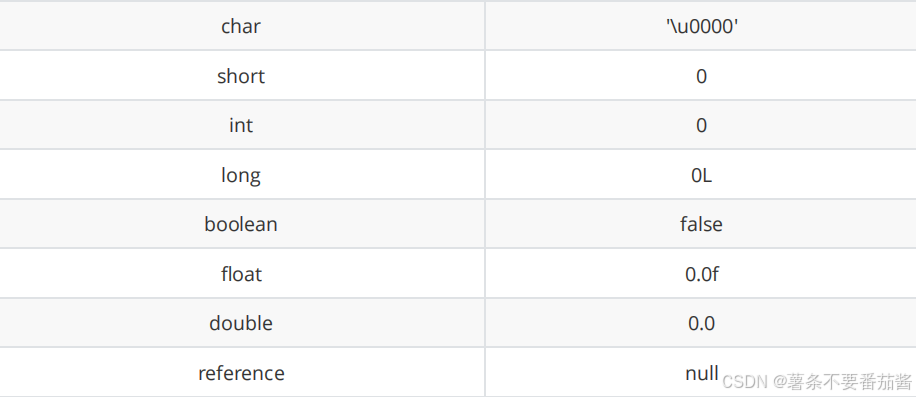
6.封装
6.1概念
面向对象程序的三大特性:封装,继承,多态.而类和对象阶段,主要研究的就是封装特性.那么什么是封装呢?简单来说就是套壳屏蔽细节.
6.2访问限定符

6.3封装扩展之包
6.3.1包的概念
6.3.2导入包中的类
public class Test {
public static void main(String[] args) {
java.util.Date date = new java.util.Date();
System.out.println(date.getTime());
}
}
import java.util.Date;
public class Test {
public static void main(String[] args) {
Date date = new Date();
System.out.println(date.getTime());
}
}
import java.util.*;
public class Test {
public static void main(String[] args) {
Date date = new Date();
System.out.println(date.getTime());
}
}
import java.util.*;
import java.sql.*;
public class Test {
public static void main(String[] args) {
// util 和 sql 中都存在一个 Date 这样的类, 此时就会出现歧义, 编译出错
Date date = new Date();
System.out.println(date.getTime());
}
}
import java.util.*;
import java.sql.*;
public class Test {
public static void main(String[] args) {
java.util.Date date = new java.util.Date();
System.out.println(date.getTime());
}
}
import static java.lang.Math.*;
public class Test {
public static void main(String[] args) {
double x = 30;
double y = 40;
// 静态导入的方式写起来更方便一些.
//double result = Math.sqrt(Math.pow(x, 2) + Math.pow(y, 2));
double result = sqrt(pow(x, 2) + pow(y, 2));
System.out.println(result);
}
}
6.3.3自定义包

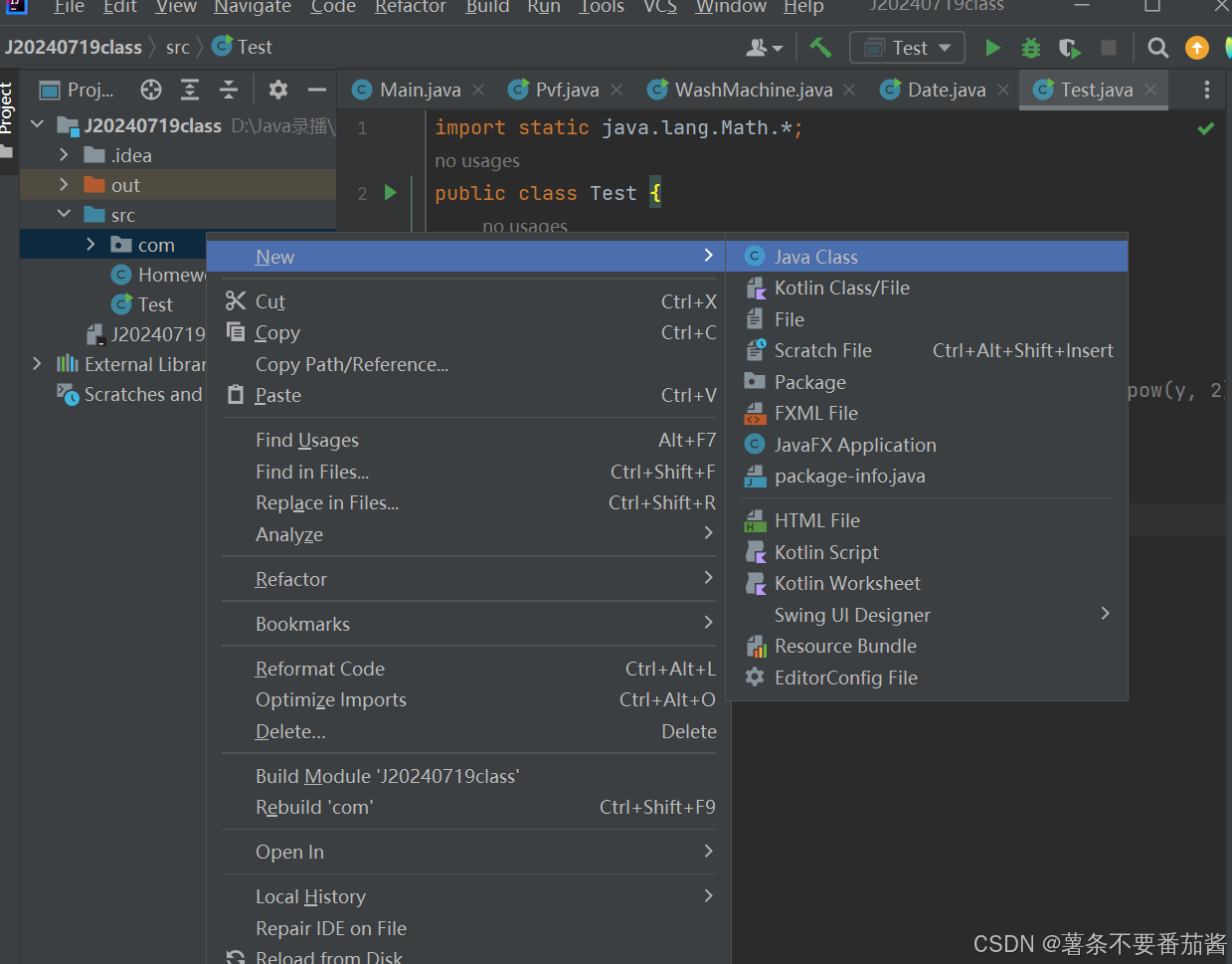
6.3.5常见的包
7.static
7.1 static修饰成员变量
public class Student {
public String name;
public String gender;
public int age;
public double score;
public static String classRoom = "306";
public Student(String name, String gender, int age, double score) {
this.name = name;
this.gender = gender;
this.age = age;
this.score = score;
}
public static void main(String[] args) {
//静态成员变量可以直接通过类名访问
System.out.println(Student.classRoom);
Student s1 = new Student("chen","男",34,4.3);
Student s2 = new Student("wu","男",19,4.29);
Student s3 = new Student("shi","女",19,3.0);
//也可以通过对象访问: 但classRoom是三个对象共享的
System.out.println(s1.classRoom);
System.out.println(s2.classRoom);
System.out.println(s3.classRoom);
}
}
7.2static修饰成员方法
public class Student {
private String name;
private String gender;
private int age;
private double score;
private static String classRoom = "306";
public Student(String name, String gender, int age, double score) {
this.name = name;
this.gender = gender;
this.age = age;
this.score = score;
}
}
public class TestStudent {
public static void main(String[] args) {
System.out.println(Student.classRoom);
}
}//编译错误:java: classRoom 在 com.baidu.Student 中是 private 访问控制
public class Student {
private String name;
private String gender;
private int age;
private double score;
private static String classRoom = "306";
public static String getClassRoom(){
return classRoom;
}
}
public class TestStudent {
public static void main(String[] args) {
System.out.println(Student.getClassRoom());
}
}
public static String getClassRoom(){
System.out.println(this);
return classRoom;
}//编译错误:java: 无法从静态上下文中引用非静态 变量 this
public static String getClassRoom(){
age += 1;
return classRoom;
}//编译错误:java: 无法从静态上下文中引用非静态 变量 age
4. 静态方法中不能调用任何非静态方法,因为非静态方法有this参数,在静态方法中调用时候无法传递this引用
7.3static成员变量初始化
静态成员变量的初始化分为两种:就地初始化 和 静态代码块初始化。
1.就地初始化
private static String classRoom = "306";
2.静态代码块初始化
继续往下看↓↓
8.代码块
8.1概念及分类
8.2普通代码块
public class Main {
public static void main(String[] args) {
{ //直接使用{}定义,普通方法块
int x = 10 ;
System.out.println("x1 = " +x);
}
int x = 100 ;
System.out.println("x2 = " +x);
}
}//输出x1 = 10
x2 = 100
//这种用法较少见
8.3构造代码块
public class Student{
//实例成员变量
private String name;
private String gender;
private int age;
private double score;
public Student() {
System.out.println("I am Student init()!");
}
//实例代码块
{
this.name = "bit";
this.age = 12;
this.gender = "man";
System.out.println("I am instance init()!");
}
public void show(){
System.out.println("name: "+name+" age: "+age+" sex: "+gender);
}
}
// 运行结果
/*I am instance init()!
I am Student init()!
name: bit age: 12 sex: man*/
























 被折叠的 条评论
为什么被折叠?
被折叠的 条评论
为什么被折叠?








